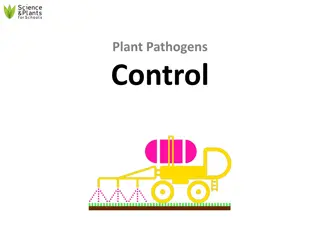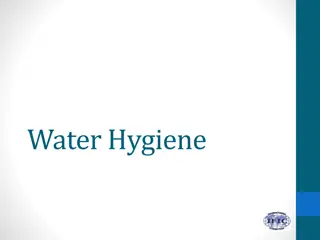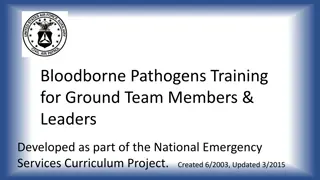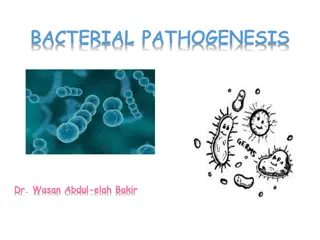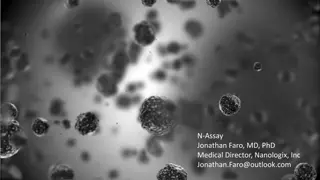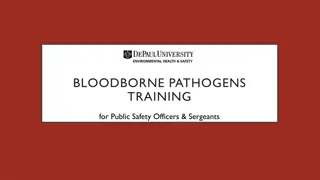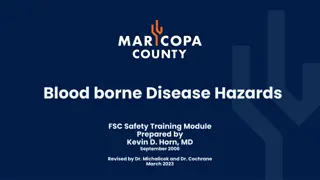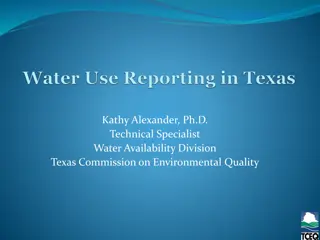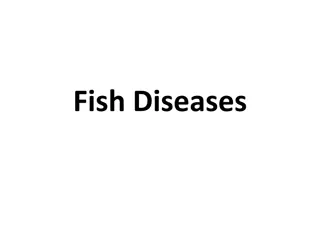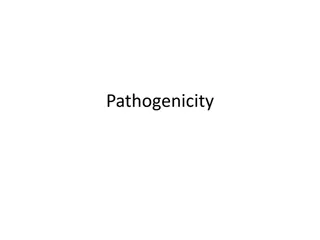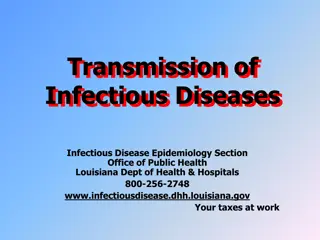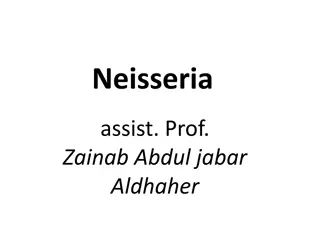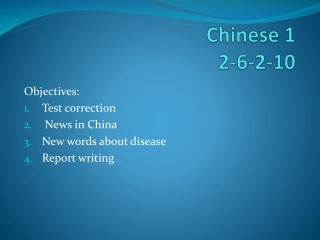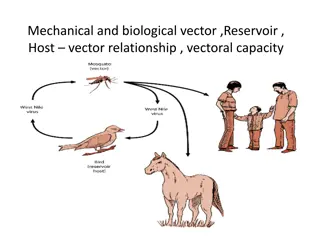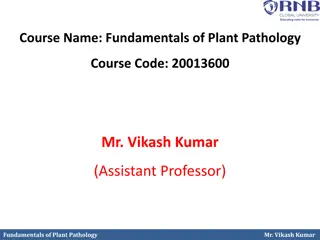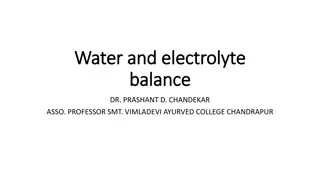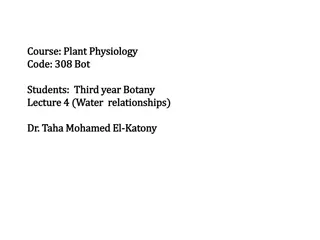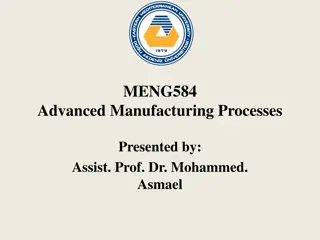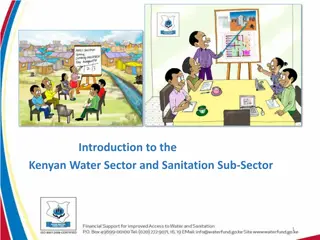Understanding Water-borne Diseases and Pathogens
Drinking contaminated water can lead to water-borne diseases, causing millions of deaths annually, especially in developing countries. Potable water is essential for health and development, as water-related diseases arise from inadequate water quality and poor sanitation practices. Various pathogens transmitted through oral-fecal route pose health risks, including bacteria like E. coli and Vibrio cholerae, as well as viruses like Hepatitis A and Rotavirus.
Download Presentation

Please find below an Image/Link to download the presentation.
The content on the website is provided AS IS for your information and personal use only. It may not be sold, licensed, or shared on other websites without obtaining consent from the author. Download presentation by click this link. If you encounter any issues during the download, it is possible that the publisher has removed the file from their server.
E N D
Presentation Transcript
Water borne diseases Prepared by G.K.ARACHI
Introduction Drinking water is a major sourceof microbialpathogens in developingcountries. Waterborne disease cause more than 2 million deaths and 4 billion cases of diarrhea annually. 9 out of 10 deaths are in children and virtually all of the deathsare in developing countries.
The importance of water quality Safe water is a precondition for health and development and a basic human right. Water-related diseases caused by insufficient safe water supplies coupled with poor sanitation and hygiene.
Termsto be known Potable(clean)water: it is free of all objectional material, including pathogens, tastes, odors, colours, toxins, radioactive material, organisms, oils, gases, etc. contaminated or polluted water Water contaminated with sewage, domestic or industrial waste with chemicals and pathogenic microorganisms .
Water-borneDiseases Diseases caused by ingestion of water contaminated by human or animal faeces or urine , which contain pathogenic microorganisms
Many bacteria, viruses, protozoa and parasites can cause disease when ingested. The majority of these pathogens derive from human or animal faeces, and are transmitted through the faecal-oral route. Although both animal and humanfaeces are threats to human health, human faeces are generally the most dangerous. Faecal pathogens can be classified as causing both water- borne and water-washed diseases.
Orally transmitted waterborne pathogens Bacteria Campylobacterjejuni/coli E. coli enterohaemorrhagic Legionellaspp. Salmonellatyphi Shigella spp. Vibriocholerae Yersinia enterocolitica Pseudomonasaeruginosa
Viruses Adenoviruses Enteroviruses(polio) Hepatitis A Hepatitis E Noroviruses and Sapoviruses Rotavirus
Protozoa Cryptosporidium parvum Entamoeba histolytica Giardia lamblia/intestinalis Naegleria fowleri Toxoplasma gondii
Helminths Dracunculus medinensis. Schistosoma spp.
Diseases that transmitted by water can be divided in to: 1. Diarrhoeal water-bornediseases 2. Non-diarrhoealwater-borne diseases
Diarrhoeal water-borne diseases Most water-borne pathogens infect the gastrointestinaltract and cause diarrhoeal disease. The most common causes of severe diarrhoeal disease are: -Rotaviruses. -Pathogenic E. coli -Campylobacterjejuni. -Entamoeba hystolica -Giardia intestinalis (also known as G. lamblia) -Cryptosporidium parvum -Norwalk-like viruses
Epidemic diarrhoealdisease Twodiarrhoeal pathogens: Shigelladysenteriae Vibriocholera -are particularly infectious and can causesevereepidemics. -Epidemic diarrhoea (both shigellosis and cholera) can be triggered by natural disastersor political upheavals that disrupt the normal water supply.
Non-diarrhoeal water-borne diseases While most water-borne pathogens cause diarrhoealdisease, a few important water-borne diseases affect other parts of the body: Typhoidfever is caused by ingestion of Salmonella typhi bacteria in food or water and affects about 17 million people each year, causing some 600,000 deaths. Hepatitis(or liver inflammation) is caused by viral infection. A and E, are primarily caused by ingestion of faecally contaminated drinking water. Hepatitis A causes about 1.5 million infections each year (mostly in children)
Polio is a highly infectious viral disease that mainly affects children under 5. poliovirus is primarily transmittedthrough the faecal-oral route, safe water and sanitation interventions can help reduce risk. Legionellosis Legionella can grow in water storage tanks, boilers, or pipes in distribution systems. Outbreaks of Legionnaire sdisease are fairly rare.
Leptospirosis is a bacterial disease caused by ingestion or bodily contact with water contaminated with the urine of infected animals, especially rats. The disease is difficult to diagnose and is often overlooked, but may be important, especially following flooding.
Water-washedDiseases Diseases caused by poor personal hygiene and skin and eye contact with contaminated water
Four types of water-washed diseases are considered here: 1. Soil-transmitted helminths transmitted primarily through contact with contaminated soil. The most prevalenthelminths are: Ascaris (Ascarislumbricoides) hookworm (Ancylostoma duodenale and Necator americanus) whipworm (Trichuristrichiura). -helminths cause about 12,000 deaths each year -improved hygiene and sanitation can reduce disease incidence. Ascaris lumbricoides
2. Acute RespiratoryInfections Acute respiratory infections (ARI) including pneumonia are responsible for approximately 19% of total child deaths every year. There is an increasing body of evidence demonstrating that good hygiene practices, especially hand-washing with soap, can significantly reduce the transmission of ARI
3. Skin and eye diseases Trachoma Trachoma is caused by the Chlamydia trachomatis bacteria, which inflame the eye. The best control methodfor trachoma is improved access to waterfor face washing.
Ringworm(tinea) is an infectious disease of the skin, scalp or nails. In spite of the name,the disease is caused by the fungus(tinea corporis).
Water-basedDiseases Diseases caused by parasites found in intermediate organisms living in contaminated water
Schistosomiasis(bilharziasis) Infection is caused by flatworms called schistosomes, which spend part of their life cycle inside snail hosts. People become infected through skin contact with infected water, mainly during fishing and agriculturalactivities.
Dracunculiasis(guinea-worm disease) caused by the roundworm Dracunculus medinensis. Guinea- worm larvae in water bodies are ingested by the Cyclops water flea. People become infected by drinking water contaminated with Cyclops: the larvae are released in the stomach, migrate through the intestinal wall, and grow to adult worms.
Water-relatedDiseases Water-related diseases are caused by insect vectors, especially mosquitoes, that breed or feed near contaminatedwater.
These diseases are not directly related to drinking-water quality. However, consideration of vector control can reduce the potential for water related disease transmission. The most common vector insects are mosquitoes and flies. Mosquito-bornediseases: -malaria (plasmodium-parasite) -yellow fever (virus) - dengue fever (virus) - Filariasis (worm) filariasis
Fly-borne diseases - onchocerciasis(river-blindness) caused by filarialworm Onchocerca volvulus - trypanosomiasis (West African sleeping sickness)caused by a parasite - calledTrypanosoma bruce - leishmaniasis (Kala-azar) Kala-azar - Loiasis - caused by parasitic worm Loa loa Loiasis




